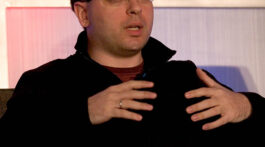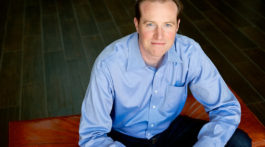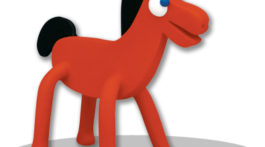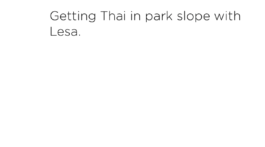Jan Brandt is a legend in the world of marketing. She singlehandedly led the famous AOL “carpet-bombing” campaign that put millions of AOL trial discs and CDs in everything from magazines to popcorn boxes to banks. In the most recent episode of the Internet History Podcast, I spoke to Jan about this famous campaign, how the strategy developed and the analytics and data that went into it. What follows is a lightly edited transcript of portions of our conversation. Click above to listen to the whole thing, or download it in iTunes here.
Brandt was been recruited to AOL in 1993 with a simple mission: grow the subscriber base. At the time, online services were a novel product. The majority of American homes didn’t have computers yet, much less, computers with modems. Also, AOL was a distant 3rd or 4th in the online services market, behind CompuServe and Prodigy. So Brandt was given free reign to get creative with her marketing efforts. Prodigy was famously spending millions of dollars on flashy television ads. But Brandt was convinced that old-school, unsexy, direct marketing might be the key to standing out. After all, she needed to get people to try the service, and the only way to do that was to get the AOL installation discs in their hands.
We started packaging them [the installation discs] in boxes and tins and things like that. It was my absolute belief that you could not send someone a package in the mail—and I don’t mean an envelope, I mean a package that you could feel—and not open it. I felt that it was constitutionally impossible for someone to get a small box in the mail and not be inspired to open it.
Armed with this belief, she phoned up her boss, AOL CEO Steve Case, and asked for money to experiment with a direct mail campaign. Case was skeptical, but gave her the go-ahead.
The campaign was going to cost $250,000 and that was our first campaign. It was a lot of money for us at the time. Steve teased me that it wasn’t going to work. I mean, he has, you know, something of a dry wit. But he backed me completely. He backed me on that and he backed me on the next millions of dollars.
It turned out that the campaign exceeded her wildest expectations. In the direct marketing arena, a response rate of 2-3% for a campaign is considered a home run success. But Brandt was seeing response rates which were multiples of that.
I’ve done a lot of first campaigns and launched a lot of products […] I have never— this was beyond imagination. […] The overall response to that campaign was a staggering over 10% uptake. And remember, this isn’t people who are saying, ‘I think I want this.’ These are people who are taking the disc, putting it into the computer, signing up, and giving us a credit card. The top list, for that, I have never seen in my life before—or since—was a 20% response. It was stratospheric.
When I saw that, honestly, it was better than sex.
This emboldened Brandt to start thinking even more outside the box. All she needed to do was get discs in peoples’ hands. What other ways could she reach people? Inspiration struck her one Friday night at Blockbuster, after a long workweek.
On the weekends, I’d go into Blockbuster and I’d pick up like eight movies at a time. Weekends, for me, was watching movies and working. And they had a sample box there. If you took three movies, you could get one of these boxes free. And in the box were things like product samplings. […] I walk up to the front desk with my eight movies, because I don’t know what mood I’m gonna be in on Sunday. And I said, ‘I’ve got eight movies, and I’m taking two of these boxes.’ Monday morning I took them into [the office] and said, ‘I want you to get us a disc in here.’
[…]We knew that one of the cohorts that was important for us in the early days was ‘presence of children in the home.’ People were buying computers, frankly, I think… this will be good for school and for kids and the homework. But actually, I think, it was the father that wanted to tinker with the computer. And so, I’m looking in Blockbuster, and I’m saying, ‘There’s a lot of guys in here and I know that they have kids.’
[…]Blockbuster was the first one. Blockbuster to me, was really an inflection point. It was the first one where I said, ‘Oh, my god. We’re really mass-market.’ […] And the response to that was about 3%. The percentages really depend on the product and the offer. Sort of a rule of thumb is, in terms of a box like that, a take-one box, usually you’re happy to see something at about a 0.3% response. So we’re at 10X and I’m like, ‘Wow!’ And that was really what started… it was the Blockbuster box that put me off to the races.
[…]And then it was, we will try anything.
And they did. Soon, AOL discs, were soon popping up everywhere. On airplane seats. In cereal boxes. On the counter at your bank. They were willing to experiment with almost any partner.
We packaged floppies into packages of Omaha Steaks. So that sounds interesting all by itself. But what we had to do was flash freeze the floppy. Thaw it out… cause it had to travel with flash frozen meat. We had to thaw it out and see if it still worked. And, it did.
Brandt was so fanatical about making it easy to get discs in people’s hands that, for a long time, she fought other executives inside the company to keep the startup program small… so it could still fit on one single disc.
I was crazed about that. There was a lot of struggle internally, because the software [to install AOL] was becoming more and more complicated. […] And, yeah, I wouldn’t allow it to go on to two floppies. Because, it’s all about the consumer, stupid. It really is. And making it easy and taking away barriers is what good marketing has to do. I really felt that having it on two floppies, and have to manipulate that would be a barrier. We’re talking about back in days when I did focus group research–and we’re watching this–and someone took a computer mouse and is pointing it at the computer like a remote control. And one person put it on the floor and tried to use it like a sewing machine pedal.
So for a long time, AOL software was not as sophisticated as it could have been because Brandt fought to keep it simple for the marketing campaigns.
Eventually, of course, the software migrated over from floppy discs to CD-Roms. CDs were cheaper to produce and virtually indestructible. There is a famous Quora thread that both Brandt and Steve Case commented on, with Brandt claiming, “At one point, 50% of the CD’s produced worldwide had an AOL logo on it.” I asked her if those numbers were correct and how much AOL would go on to spend on these sorts of marketing efforts during the lifetime of the campaigns.
That’s absolutely correct.
If you’re asking the question in terms of total marketing spend, it was definitely in billions.
The ‘carpet-bombing’ of discs and CDs was instrumental in catapulting AOL to the head of the online services market. So much so that it begs the question why competitors didn’t just copy what Brandt was doing.
Someone once asked me what kept me up at night. I said, ‘I wake up every morning worried that I’m going to see Prodigy or CompuServe using the discs the way that we’re using them. That I’m going to see it stuck on the front of a magazine or see it in the mail.’ And the thing that was really interesting… I gave very few interviews. I would never have talked to them [the press] the way I’m talking to you about it now. Because I felt like I was sitting there with the secret sauce.
Ted Leonsis [another AOL executive] was once on a panel with someone from CompuServe. And the guy from CompuServe said to Ted, ‘You guys are crazy. And that person running marketing has gotta be a nutcase with the amount of money that you’re spending on these discs.’
And Ted comes back and reports this to me. And I said, ‘Next time someone says that, agree that I’m a dumb broad, and that you’ve been trying to get me fired from the company for a long time.’ And the reason for that, really, is, I couldn’t believe that they weren’t trying it.
But AOL’s success did get the attention of Microsoft. Before launching MSN as a direct competitor to AOL, Bill Gates came calling to feel AOL management out about an acquisition.
I wasn’t at this meeting. So, I just know this from hearsay but the hearsay was from a very high source. This was a meeting in which Bill Gates basically said, ‘I can buy you or bury you.’ I don’t know if those were his exact words but that was the content that I got out of it. I remember Steve and I having lunch shortly after that, and I just looked at Steve and said, ‘Well, what are we going to do?’
And he says, ‘I’m not selling.
Case was right to stick to his larger vision of AOL as something more than just Microsoft’s online entrant. AOL, in no small part thanks to Brandt’s continued efforts, would handily defeat MSN in the marketplace. Brandt credits AOL’s triumph, again, to simple marketing…
It was the product positioning. Our service was called America Online. Microsoft’s service was called Microsoft Network. It really showed the focus of the companies in my view. Microsoft about Microsoft and AOL about customers. And CompuServe was just sort of a geeky name.
…but also to an early deal that AOL struck with Microsoft to make Internet Explorer the default web browser on AOL, in exchange for getting AOL an icon presence on the Windows 95 desktop. This was in the era when Microsoft and Gates were doing battle with Netscape for browser supremacy. Microsoft was booting Netscape’s Navigator off the desktop; but AOL was now gaining this prime foothold, and it would prove to be insanely valuable real estate.
I believe that the subscribers we got from them [Microsoft] were either free or very low cost. And we were getting 600,000 subscribers a year from that source. It was huge. It was a sweetheart deal but it could have backfired.
Indeed, there was fear inside the company that Brandt’s own success in growing the subscriber base might backfire. Occasionally, she was subtly encouraged to ease up a bit so that the network could absorb all the millions of new users she was bringing in.
In our first offices in Vienna Virginia, we had taken over some offices that were owned by some high security firm. They had this big safe. Huge safe. Like a small room. It was on the technology floor and I was up there visiting somebody in technology. They sort of lured me into the room, and I didn’t know what it was, and locked me in there. And said, ‘Now, stop it.’ All in jest. People would come and tell me to, you know, take my foot off the gas. And I didn’t.
But the fears were not unfounded. Most famously, when AOL switched to unlimited monthly usage and flat rate pricing (as opposed to billing by the hour like it had done since the service’s inception) the influx of users who could now stay online all day almost broke the network and the company.
This is where I give Steve [Case] just, enormous, enormous credit for his vision and understanding. He was on the right side of this, and that was to absolutely go unlimited. And I was not, initially. I had data and I had projections on how much money we would lose. […] We had so many people that were paying us $50, $60, $70 [a month, because of the hourly fees and overage charges as they existed at the time]. So for a long time, Steve and I had a lot of discussions. And he brought me over to his side; but I have to say that it’s a decision that was very, very, very tough for the company. It took its toll all over the company because it was so controversial and had such a huge impact, not only on the finances. It was like jumping off a cliff.
It would be hard to say that there was no panic. I know that we really didn’t anticipate the extent of… we knew there was going to be a problem but we really didn’t anticipate the extent of it. We didn’t really have an internalized grip on how important we were to people’s daily lives. What we didn’t calibrate was the ferociousness of the response. It was crazy and it was really enlightening. It was like, ‘Oh my God! People love us! They really love us!’
Or, at that point, they love-hated us.
AOL would, of course, survive the “America On Hold” fiasco, and continue its growth trajectory, eventually passing 20 million subscribers and, by the late 90s, was singlehandedly responsible for the vast majority of Internet usage.
When I asked what other factors contributed to AOL’s dominance in the late 90’s, Brandt was quick to point to a single product: AOL Instant Messenger, or AIM, which was launched after AOL purchased ICQ.
I really think it [AIM] was the foundation of how we’re all communicating now. It’s the predecessor to texting. I looked at the purchase of [Whatsapp] and I said, ‘It’s what we did. It’s like ICQ.’ In the instance of ICQ [like Whatsapp] they were largest internationally. Our footprint was huge almost exclusively in the United States.
And of course, AOL’s wild success would, at the end of the Dot Com era, lead to the merger with Time Warner, which was decidedly not such a wild success.
I really felt, personally, that it was brilliant conceptually. […] They had amazing content, and let’s not forget, they had the cable company. It was at a time when we were struggling to cut any kind of reasonable deal on broadband. People will say to me, ‘Well, gee, why didn’t you guys do broadband back then?’ And I sort of smack my head [sarcastically] ‘Oh! We never thought of that!’ […] The deals we were able to cut [with broadband providers] were just crazy and expensive. It was horrible. So, the notion of getting a cable company was brilliant. And the content that came with Time Warner was amazing.
It [AOL] was a very different culture than these brilliant and fabulously successful brands that Time Warner had that were operating mostly in silos. It was a humungous clash of centralized vs. decentralized. […] What had happened, also, on the Time Warner side is that all of the sudden they had these AOL options in their pensions and so forth… and this is just me speaking… All the sudden, they’re looking at their pensions and stock options and so forth that aren’t worth what they were. And this is almost coincident with them merging with us. And so I think that there was a great feeling that if they just had stayed Time Warner, their pensions would not be worth now 50% of what they were before. You can understand where some of the angst came from.
We were… AOL was riding on top of the world, I’m sure we had our own form of arrogance.
If you’re interested in more Internet History, there’s plenty more where that came from. Subscribe to the Internet History Podcast on iTunes. Or visit the website here.













[…] started somewhere in the middle with an interview with Jan Brandt, the lady who led AOL’s marketing. She came up with the idea to spread first floppy discs and […]
[…] to Xerox, Brandt was hired as vice present of marketing for AOL, where she hit the headlines with a “carpet bombing” marketing strategy, that saw AOL subscribers rise from a paltry 20000 to over 22 million. Brandt continues to serve at […]